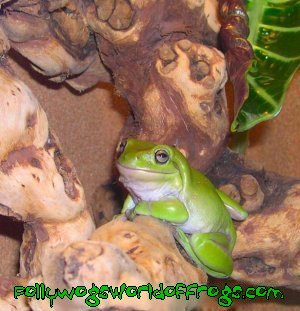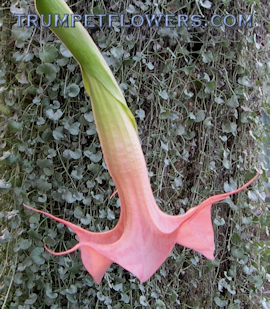White's Treefrog Caresheet

 Litoria caerulea belongs to the subfamily pelodryadinae. This particular species
lives in nature throughout northern and eastern Australia to southern New South Wales
and into Southern New Guinea. It has also been introduced into New Zealand.
Litoria caerulea belongs to the subfamily pelodryadinae. This particular species
lives in nature throughout northern and eastern Australia to southern New South Wales
and into Southern New Guinea. It has also been introduced into New Zealand.
 The frogs can reach from 2-3/4" to 4-1/2" long. Females are usually larger,
but not in all cases. Also a good place to note, they have been found and
documented in their native environment up to 6" long. Females have also
been known to squawk when they
feel threatened, but not as long a call as the male would give. To properly sex them,
one should wait to observe as adults and when in the mating season.
The frogs can reach from 2-3/4" to 4-1/2" long. Females are usually larger,
but not in all cases. Also a good place to note, they have been found and
documented in their native environment up to 6" long. Females have also
been known to squawk when they
feel threatened, but not as long a call as the male would give. To properly sex them,
one should wait to observe as adults and when in the mating season.
It naturally lives in dry as well as humid forests, and is a tree dweller. Large "suction cup discs" are found on each digit, and it is quite capable of hanging tightly onto whatever object it finds itself on. (I have had them jump up onto me when cleaning tank and stick so well to my arm that they had to be "peeled off"!) Nocturnal, this frog species breeds after the rains arrive. The males have been found calling from all sorts of places; trees, rocks and even the ground. His loud call lasts for up to 40 seconds before he briefly rests, only to call again. During rainy season, mine call about 15 seconds in the first part of the evening. As night progresses, so does the length of the call.
Several hundred up to 2000 eggs are laid in water in clutches. Metamorphosis takes place anywhere between 4 and 6 weeks. Incidentally, the drug labeled Caerulin, which is used to control hypertension, was discovered in the skin of this frog. Today it has been synthesized and is used to treat this disorder. Another chemical secreted from this frog has been shown to help fight herpes.
Setup
Because this is a large frog, no less than a 30 gallon vivarium is required. For
3 make it 40, and so on. They would rather "walk" from branch to branch,
but need to be able to feel uncrowded, so under-sizing the vivarium is not suggested. When hunting, they will leap after their prey,
another reason to make their environment quite roomy.
Taller than is wider, treefrog-style. The frogs should be given sterilized grapevine
limbs to climb upon, and at least one with a
 large hollow in it for them
to hide and sleep in daylight hours.
Tilt one or two of the branches downward and upward so the frogs can position
themselves accordingly under a basking lamp.
A plastic den on the ground is also helpful.
Silk or vining live plants can be twisted around a limb to provide more comfort.
large hollow in it for them
to hide and sleep in daylight hours.
Tilt one or two of the branches downward and upward so the frogs can position
themselves accordingly under a basking lamp.
A plastic den on the ground is also helpful.
Silk or vining live plants can be twisted around a limb to provide more comfort.
 The tank should have a
The tank should have a

 false bottom with
false bottom with

 organic foam or Scotts ground peat moss substrate with
scattered riverstone. They eat a lot, so also poop a lot. False bottoms allow thorough cleaning, keeping
the frogs healthy and disease free. Always supply a deep water dish, large enough
for two or three frogs to sit in at a time. Place smooth riverstone in the bottom to make sure they can leave the dish. If the water is not filtered, clean
and scrub it out every other day, and replace with rain water that you've added liquid trace minerals to or use spring water (bottled).
organic foam or Scotts ground peat moss substrate with
scattered riverstone. They eat a lot, so also poop a lot. False bottoms allow thorough cleaning, keeping
the frogs healthy and disease free. Always supply a deep water dish, large enough
for two or three frogs to sit in at a time. Place smooth riverstone in the bottom to make sure they can leave the dish. If the water is not filtered, clean
and scrub it out every other day, and replace with rain water that you've added liquid trace minerals to or use spring water (bottled).
Feed young adults 5 to 9 insects every other evening, that are dusted every other feeding with vitamin powder. Feed the larger adults 8 to 10 insects either nightly or every other night. Unlike most other species, I dust their food source every other time it is offered. Variances in arthropods include white grubs, sterile company-raised slugs, large green flies, bollworms and roaches. Some froggers offer them a pinkie mouse once a month, but I personally don't...they can become attached to this food source and then refuse their staple diets! I have offered mine nightcrawlers, but for some reason, they won't touch them. Maybe you'll have better luck, as they contain no chitin, it would be healthy if they'd learn to munch on them.
These frogs enjoy basking, so supply them a heat bulb lamp on one side of their enclosure. If you have live plants in their enclosure, use a regular large plant light instead of the heat lamp. Plant lights also create heat, and will keep the plants healthy. I have used plant lights with my adult frogs of many different species for many years now with no ill effects to the frogs. And whites seem to love them, congregating under the large bulb every day to sleep and "sun". Indirect sun can replace this, but be sure the vivarium receives no direct sun.
Keep humidity levels low to moderate, between 35% and 60%. Mist their tank
once every other day with spring or mineral water (bottled). Don't mist the frogs themselves, they don't like it at all. If you want to use rain water you've collected, that's okay too, if you properly test and treat it.
Click this link to learn how. Once every month to 6 weeks, spray the
tank with Nolvasan (your vet has this) at the time of your general house cleaning. Do this with frogs removed, of course.
Be sure to spray
their 
 drink patch rests
especially well.
drink patch rests
especially well.
Temperatures can be in the range from 70° to 88°, the lower being evening dropoff. Keep them away from drafts.
They have been known to live in captivity for up to 20 years.
Do not handle this anuran unless absolutely necessary, and then use Proper procedures.
Further Onsite Help
Basic Frogcare (choosing healthy frogs, species mixing, feeding, etc.)
Vivariums (to establish and maintain, lighting, substrate ideas, etc.)
Quarantine (keeping main vivarium disease-free, how to set up quarantine tank)
Water 101 (How to establish & maintain high quality water)
Raising Insects (Info about raising your own insects, including grubs)
Frog Breeding (Savannah style setup information)
For more photos
 Young male Litoria
See also: Litoria caerulea basking &
Young male Litoria
See also: Litoria caerulea basking & ![]() Female Litoria
Female Litoria
 Litoria caerulea, bathing
Litoria caerulea, bathing


